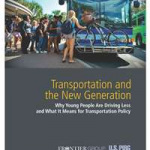Transportation and the New Generation
Why Young People Are Driving Less and What It Means for Transportation Policy
From World War II until just a few years ago, the number of miles driven annually on America’s roads steadily increased. Then, at the turn of the century, something changed: Americans began driving less. By 2011, the average American was driving 6 percent fewer miles per year than in 2004.
U.S. PIRG Education Fund & Frontier Group

From World War II until just a few years ago, the number of miles driven annually on America’s roads steadily increased. Then, at the turn of the century, something changed: Americans began driving less. By 2011, the average American was driving 6 percent fewer miles per year than in 2004.
The trend away from driving has been led by young people. From 2001 and 2009, the average annual number of vehicle-miles traveled by young people (16 to 34-year-olds) decreased from 10,300 miles to 7,900 miles per capita – a drop of 23 percent. The trend away from steady growth in driving is likely to be long-lasting – even once the economy recovers. Young people are driving less for a host of reasons – higher gas prices, new licensing laws, improvements in technology that support alternative transportation, and changes in Generation Y’s values and preferences – all factors that are likely to have an impact for years to come.
Federal and local governments have historically made massive investments in new highway capacity on the assumption that driving will continue to increase at a rapid and steady pace. The changing transportation preferences of young people – and Americans overall – throw those assumptions into doubt. The time has come for transportation policy to reflect the needs and desires of today’s Americans – not the worn-out conventional wisdom from days gone by.
The recession has played a role in reducing the miles driven in America, especially by young people. People who are unemployed or underemployed have difficulty affording cars, commute to work less frequently if at all, and have less disposable income to spend on traveling for vacation and other entertainment. The trend toward reduced driving, however, has occurred even among young people who are employed and/or are doing well financially.
America has long created transportation policy under the assumption that driving will continue to increase at a rapid and steady rate. The changing transportation preferences of young people – and Americans overall – throw that assumption into doubt. Policy-makers and the public need to be aware that America’s current transportation policy – dominated by road building – is fundamentally out-of-step with the transportation patterns and expressed preferences of growing numbers of Americans. It is time for policy-makers to consider the implication of changes in driving habits for the nation’s transportation infrastructure decisions and funding practices, and consider a new vision for transportation policy that reflects the needs of 21st century America.
